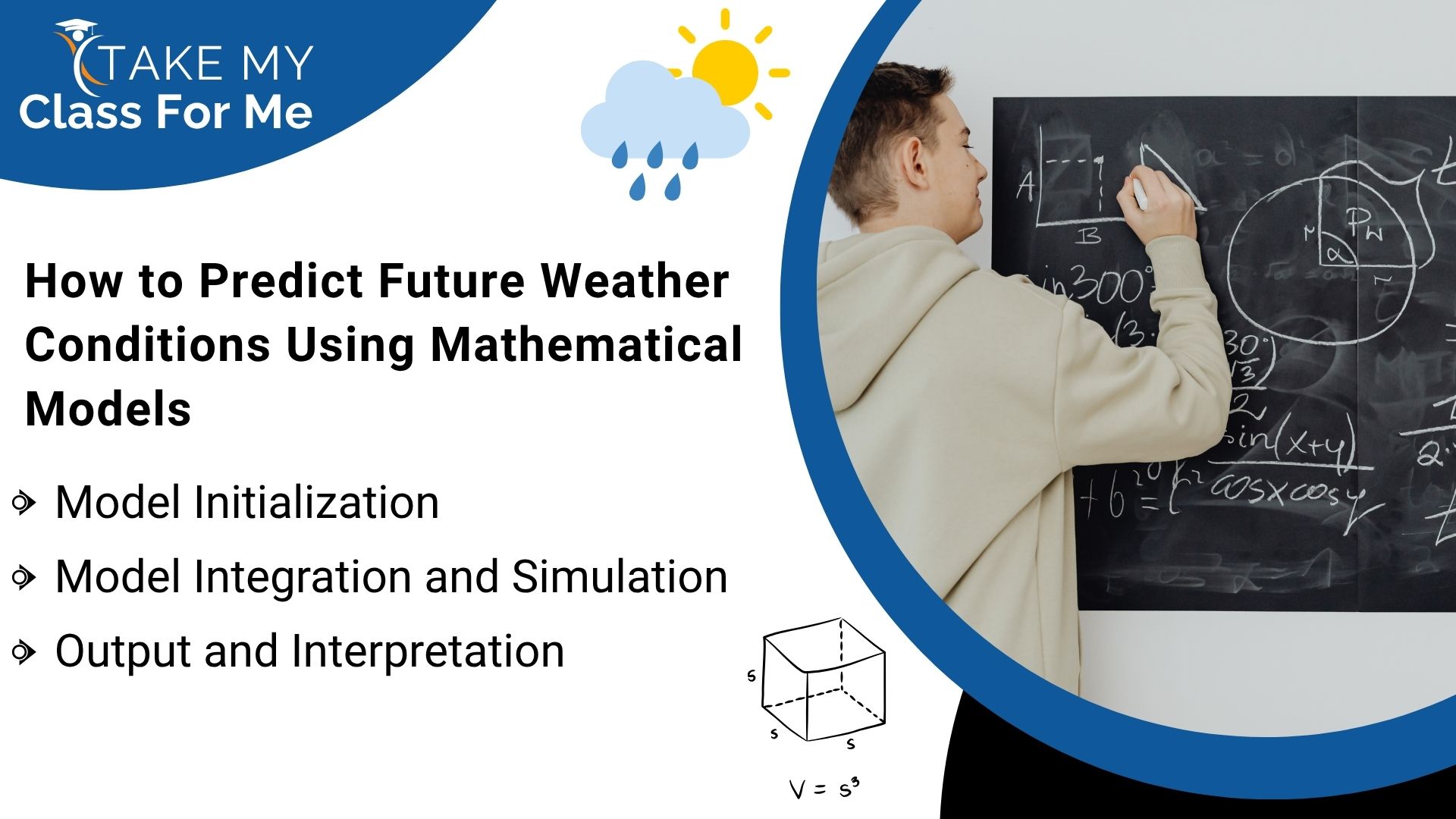Learning how to use mathematical models for accurate weather forecasting will help you make better predictions about the weather. By using numerical models, math techniques, complex algorithms, and data, you can improve the accuracy and reliability of your forecasts. This can help you save lives and resources by providing critical weather information to communities and industries.
Weather forecasting deals with the prediction of the atmospheric conditions at a particular time and place. In general, accurate weather forecasts are important for public safety, agriculture, and other industries. Earlier, meteorologists forecasted weather using data from weather stations, satellites, and sensors. However, nowadays, new technologies like computers and machine learning have improved weather forecasting by processing large data, detecting complex patterns, and making accurate predictions. Especially to predict weather with high accuracy, meteorologists will collect data based on factors such as humidity, temperature, and wind speed, and then they will use mathematical models to understand how the atmosphere behaves. Overall, weather forecasting depends on mathematical models, algorithms, and climate data.
If you want to know how to use mathematical models for accurate weather forecasting, then read this blog. Here, we have discussed the most effective means of predicting upcoming weather conditions through numerical models.
Weather Data Sources for Forecasting
If you want to predict the weather, you must have important data such as wind speed, temperature, pressure, etc. So, to collect the weather data, approach the necessary sources. The following are the major sources from which you can find the data inputs for weather models
Satellite Observations
Satellites will generally collect important data about the atmosphere, including temperature, cloud cover, and humidity. You can use this information from satellites to update weather forecasting models. As a result, you can predict the weather with more reliability and accuracy and issue timely warnings for severe weather events.
Weather Stations
Ground-based weather stations will measure local conditions like wind speed, temperature, and pressure. You can use this information to get more accurate weather forecasts for your specific region.
Data Assimilation
Data assimilation is an important process that focuses on collecting real-time data from various sources, like satellites and weather stations, and feeding it into computer models. This will help you create a precise picture of the current atmospheric conditions. Also, data assimilation will increase the reliability of climate models and weather forecasting algorithms.
Important Math Concepts in Weather Prediction
Mathematical models play a crucial role in weather forecasting. They will typically use equations to simulate and predict weather conditions accurately. Here, let us look at some key mathematical concepts that are commonly used in weather predictions
Finite Difference Methods
Finite Difference Methods solve complex equations by looking at the differences between values at specific points. When working with weather forecasting models, you should divide the atmosphere into a grid and use these methods to calculate the behavior of fluids and heat within each grid section.
Statistical Stimulations
This method uses statistical techniques to create multiple possible future weather scenarios. As a meteorologist, you can use these models to improve the accuracy of your weather predictions.
Differential Equations
Differential equations like the Navier-Stokes equations are necessary for describing the variation of atmospheric conditions with time. By using these equations, you can model the motion and dynamics of the atmosphere. Also, it will enable you to numerically predict the future weather patterns accurately.
Types of Mathematical Models for Weather Forecasting
Mathematical models are useful tools that will help you analyze equations to understand the atmospheric behavior. Moreover, by using the mathematical models, you can predict future weather conditions. These are some major mathematical model types that will be helpful for you in forecasting the weather
Numerical Weather Prediction Models
These models use special algorithms to solve complex math problems, and they will help you describe how the atmosphere works. Generally, in this model, to assist you in making detailed weather predictions, the atmosphere behavior will be divided into factors like wind speed, temperature, and pressure.
These are some well-known Numerical Weather Prediction (NWP) models
Global Forecast System (GFS): It is developed by the US. GFS will help you predict various weather conditions accurately.
European Centre for Medium-Range Weather Forecasts (ECMWF): It will provide you with high-resolution forecasts and help you predict future weather conditions with great accuracy.
The advancements in computing power and forecasting algorithms have made these models more powerful and accurate. Hence, it allows for better weather forecasts.
Statistical Models
Statistical models will look at past weather data and will help you find patterns and connections. Especially with those patterns, you can predict future weather conditions. Typically, to make accurate weather forecasts, statistical models will use techniques that analyze past observations of factors like temperature and humidity. You can even combine the statistical models with other types of models to make the weather predictions even more accurate.
How to Predict Future Weather Conditions Using Mathematical Models

Here, let us learn how to forecast weather accurately using mathematical models like NWP
Model Initialization
In general, the accuracy of weather forecasting models will highly depend on the initial conditions that you provide. This process is called model initialization. First, you will have to input current atmospheric conditions like temperature, pressure, humidity, and wind speed into the models. Next, based on the data provided, the models will make accurate predictions for you. To confirm whether the initial conditions are accurate, you can use data assimilation techniques. These techniques will integrate real-time data into the models and will help you in identifying the current atmospheric conditions.
Model Integration and Simulation
Forecasting algorithms will simulate atmospheric behavior with mathematical equations. Especially, these mathematical equations will help you in describing the pattern of the atmosphere. As a part of this process, the atmosphere will be divided into several small 3D segments. This will enable the model to monitor factors such as temperature, wind, and humidity.
Output and Interpretation
Finally, you can use the results from the forecasting models to make weather predictions. If you want to interpret the results better, then you can consider data visualization. It will help you turn complex numbers into useful information that is easy for you to understand and act on. By doing so, you can provide accurate and helpful weather forecasts.
Limitations of Using Mathematical Models for Weather Forecasting
Some challenges in using mathematical models for weather forecasting include
- Inaccurate Data: Weather forecasting models will mostly depend on initial data. But it might be hard to get accurate measurements of atmospheric conditions everywhere. Hence, this may lead to inaccuracies in predicting future weather.
- Unpredictability of Atmospheric Conditions: Usually, the atmosphere will behave randomly. Hence, small changes in initial conditions can lead to vastly different outcomes. Moreover, this will make it tough for you to predict the weather accurately over a long period.
- Uncertainty in Predictions: There will always be some uncertainty in weather forecasts. Therefore, to manage the uncertainty, you will have to use ensemble forecasting. This involves running multiple simulations with different initial conditions to get a range of possible outcomes.
How to Improve Weather Prediction Models
These are some possible ways to make weather forecasting models better and more accurate
Enhancing the Computational Power
New technologies like Artificial Intelligence (AI) and machine learning will play a vital role in improving weather forecasting. Particularly, they will help you in creating algorithms that can process large amounts of data more accurately than traditional methods. The Aardvark Weather system is an example of this technology. It will use AI to make forecasts with less data and computing power. Furthermore, it can quickly analyze data from various sources like satellites, weather stations, and balloons to provide predictions. This will make advanced forecasting possible even in areas with limited resources.
Combining Multiple Data Sources
If you want to improve weather forecasting, then you must combine data from different sources. You can use data from satellites, ground-based weather stations, and oceanic measurements. Generally, satellites will provide you with information about the atmosphere, while weather stations will give you local conditions. On the other hand, oceanic data will help you understand sea temperatures and currents that impact the weather. By bringing all this data together, you can get a more complete picture and make more accurate predictions.
Wrapping Up
By now, you will have gained a better understanding of how to use mathematical models for accurate weather forecasting. If it is challenging for you to use mathematical models to predict the weather or if you are not clear about the mathematical concepts involved in weather forecasting, then contact us for help. The math tutors in our team will assist you in handling your task effectively. Furthermore, by getting online math class help from takemyclassforme.us.com, you can improve your understanding of the subject and enhance your grades.





